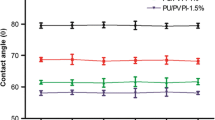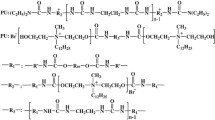Abstract
Bacterial adhesion and encrustation are the known causes for obstruction or blockage of urethral catheters and ureteral stents, which often hinders their effective use within the urinary tract. In this in vitro study, polyvinylpyrrolidone-iodine (PVP-I) complex modified polyurethane (Tecoflex®) systems were created by physically entrapping the modifying species during the reversible swelling of the polymer surface region. The presence of the PVP-I molecules on this surfaces were verified by ATR-FTIR, AFM and SEM-EDAX analysis, while wettability of the films was investigated by water contact angle measurements. The modified surfaces were investigated for its suitability as a urinary tract biomaterial by comparing its lubricity and ability to resist bacterial adherence and encrustation with that of base polyurethane. The PVP-I modified polyurethane showed a nanopatterned surface topography and was highly hydrophilic and more lubricious than control polyurethane. Adherence of both the gram positive Staphylococcus aureus (by 86%; **P < 0.01) and gram-negative Pseudomonas aeruginosa (by 80%; *P < 0.05) was significantly reduced on the modified surfaces. The deposition of struvite and hydroxyapatite the major components of urinary tract encrustations were significantly less on PVP-I modified polyurethane as compared to base polyurethane, especially reduction in hydroxyapatite encrustation was particularly marked. These results demonstrated that the PVP-I entrapment process can be applied on polyurethane in order to reduce/lower complications associated with bacterial adhesion and deposition of encrustation on polyurethanes.












Similar content being viewed by others
References
Tunney MM, Jones DS, Gorman SP. Assessment of biofilm and related problems associated with urinary medical devices. In: Doyle RJ, editor. Methods in enzymology: biofilms, vol. 310. Florida: Academic Press; 1999. p. 558–66.
Gorman SP, Jones DS. Complications of urinary devices. In: Wilson M, editor. Medical implications of biofilms. Cambridge: Cambridge University Press; 2003. p. 136–70.
Gorman SP, Jones DS, Bonner MC, Akay M, Keane PF. Mechanical performance of polyurethane ureteral stents in vitro and ex vivo. Biomaterials. 1997;18:1379–83.
Gorman SP, Jones DS, Bonner MC, Akay M, Keane PF. Mechanical performance of polyurethane ureteral stents in vitro and ex vivo. Biomaterials. 1997;18(20):1379–83.
Zisman A, Siegel YI, Siegmann A, Lindner A. Spontaneous ureteral stent fragmentation. J Urol. 1995;153:718–21.
El-Sheriff A. Fracture of polyurethane double pigtail stents: an in vivo retrospective and prospective fluoroscopic study. Bri J Urol. 1995;76:108–14.
Tunney MM, Keane PF, Jones DS, Gorman SP. Comparison of in vitro encrustation on ureteral stent biomaterials. Biomaterials. 1996;17(15):1541–6.
Tunney MM, Gorman SP, Patricki S. Medical device-related infection. Revi Med Microbiol. 1996;7(4):195–210.
Stickler D, Ganderton L, King J, Nettleton J, Winters C. Proteus mirabilis biofilms and encrustation of ureteral stents. Urol Res. 1993;21:407–11.
Holmes SAV, Miller PD, Crocker PR, Kirby RS. Encrustation of intraprostatic stents—a comparative study. Br J Urol 1992;69:383–7.
Hedelin H, Bratt CG, Eckerdal G, Lincoln K. Relationship between urease producing bacteria, urinary pH and encrustation on indwelling urinary catheters. Br J Urol. 1991;67:527–31.
Squires B, Gillatt DA. Massive bladder calculus as a complication of a titanium prostatic stent. Br J Urol. 1995;75:252–3.
Milroy E, Chapple CR. The UroLume stent in the management of benign prostatic hyperplasia. J Urol. 1993;150:1630–5.
Brehmer B, Marsden PO. Route and prophylaxis of ascending bladder infection in male patients with indwelling catheter. J Urol. 1972;108:719–21.
Gorman SP, Jones DS. Complications of urinary devices. In: Wilson M, editor. Medical implications of biofilms. Cambridge: Cambridge University Press; 2003. p. 136–70.
Wironen J, Marrota J, Cohen M, Batich C. Materials used in urological devices. J Long Term Effects Med Implants. 1997;7:1–28.
Cox AJ, Millington RS, Hukins DWL, Sutton TM. Resistance of catheters coated with modified hydrogel to encrustation during an in vitro test. Urol Res. 1989;17:353–6.
Jones DS, Garvin CP, Gorman SP. Design of a simulated urethra model for the quantitative assessment of urinary catheter lubricity. J Mater Sci Mater Med. 2001;12(1):15–21.
Hedelin I, Grenabo L, Pettersson S. Urease induced precipitation of phosphate salts in vitro on indwelling catheters made of different materials. Urol Res. 1991;19:297–300.
Liedberg H, Lundeberg T. Urease induced precipitation on latex and silver coated latex in vitro. Scand J Urol Nephrol Suppl. 1991;138:239–40.
Gorman SP, Tunney MM, Keane PF, Van Bladel K, Bley B. Characterisation and assessment of a novel poly(ethylene oxide)/polyurethane composite hydrogel (Aquavenes) as a ureteral stent biomaterial. J Biomed Mater Res. 1998;39:642–9.
Kristinsson KG. Adherence of staphylococci to intravascular catheters. J Med Microbiol. 1989;28:249–57.
Bridgett MJ, Davies MC, Denyer SP, Eldridge PR. In vitro assessment of bacterial adhesion to hydromer-coated cerebrospinal-fluid shunts. Biomaterials. 1993;14:184–8.
Jansen B, Goodman LP, Ruiten D. Bacterial adherence to hydrophilic polymer-coated polyurethane stents. Gastrointest Endosc. 1993;39(5):670–3.
Francois P, Vaudaux P, Nurdin N, Mathieu HJ, Descouts P, Lew DP. Physical and biological effects of a surface coating procedure on polyurethane catheters. Biomaterials. 1996;17:667–78.
Krasovskaya SM, Uzhinova LD, Andrianova MY, Prischenko AA, Livantsov MV. Biochemical and physico-chemical aspects of biomaterial calcification. Biomaterials. 1991;12:817–20.
Choong SKS, Wood S, Whitfield HN. A model to quantify encrustation on ureteric stents, urethral catheters and polymers intended for urological use. BJU Int. 2000;86:414–21.
Khandwekar AP, Patil DP, Khandwekar V, Shouche YS, Sawant S, Doble M. TecoflexTM functionalization by curdlan and its effect on protein adsorption and bacterial and tissue cell adhesion. J Mater Sci Mater Med. 2009;20:1115–29.
Khandwekar AP, Patil DP, Shouche YS, Doble M. Controlling biological interactions with surface entrapment-modified polyurethane. J Med Biol Eng. 2009;29:84–91.
Khandwekar AP, Patil DP, Shouche YS, Doble M. The biocompatibility of sulfobetaine engineered poly(ethylene terepthalate) by surface entrapment technique. J Biomater Appl. 2010;25(2):119–43. doi:10.1177/0885328209344004.
Khandwekar AP, Patil DP,Shouche YS, Doble M. The biocompatibility of sulfobetaine engineered poly(methyl methacrylate) by surface entrapment technique. J Mater Sci Mater Med. 2010;21(2):635–46. doi:10.1007/s10856-009-3886-y.
Khandwekar AP, Patil DP, Shouche YS, Doble M. Surface engineering of poly(caprolatone) by biomacromolecules and their blood compatibility. J Biomater Appl. 2010 (in press). doi:10.1177/0885328210367442.
Khandwekar AP, Patil DP, Hardikar AA, Shouche YS, Doble M. In vivo modulation of foreign body response on polyurethane by surface entrapment technique. J Biomed Mater Res Part A. 2010;95A(2):413–23. doi:10.1002/jbm.a.32852.
Russ IG. Energy dispersive X-ray analysis on, the scanning electron microscope, In: Energy dispersive X-ray analysis, pp. 154–179, STP, 485, American Society for Testing and 154, Philadelphia; 1971.
Egyhazi T, Scholtz J, Beskov VS. SEM-EDAX investigations of userelated microstructural changes in an ammonia synthesis catalyst. React Kinet Catal Lett. 1984;24:1–8.
Glu GB, Arica MY. Surface energy components of a dye-ligand immobilized pHEMA membranes: effects of their molecular attracting forces for non-covalent interactions with IgG and HSA in aqueous media. Int J Biol Macromol. 2005;37:249–56.
Bhat VT, James NR, Jayakrishnan A. A photochemical method for immobilization of azidated dextran onto aminated poly(ethylene terephthalate) surfaces. Polym Int. 2007;57:124–32.
Bhagat PR, Pandey AK, Acharya R, Nair AGC, Rajurkar NS, Reddy AVR. Molecular iodine preconcentration and determination in aqueous samples using poly(vinylpyrrolidone) containing membranes. Talanta. 2008;74:1313–20.
Min XC, Ping DJ, Tai YW. Synthesis of antibacterial polypropylene film with surface immobilized polyvinylpyrrolidone-iodine complex. J Appl Polym Sci. 2005;97:2026–31.
Marmieri G, Pettenati M, Cassinelli C, Morra M. Evaluation of slipperiness of catheter surfaces. J Biomed Mater Res. 1996;33(1):29–33.
Tunney MM, Gorman SP. Evaluation of a poly(vinyl pyrollidone)-coated biomaterial for urological use. Biomaterials. 2002;23:4601–8.
Tunney MM, Banner MC, Keane PF, German SP. Development of a model for assessment of biomaterial encrustation in the upper urinary tract. Biomaterials. 1996;17:1025–9.
Ovsepyan M, Kobyakov VV, Dubrovin VI, Panov VP. Determination of polyvinylpyrrolidone in aqueous solutions by infrared spectrophotometric and spectrofluorimetric methods. Khimiko-Farmatsevticheskii Zhurnal. 1978;12:121–4.
Qipeng G, Jinyu H, Li Xiaoqing. Miscibility of poly(n-vinyl-2-pyrrolidone) with poly(hydroxyl ether of phenolphthalein) and polyacrylonitrile. Eur Polym J. 1996;32(4):423–6.
Qian X-f, Yin J, Feng S, Liu S, Zhu Z. Preparation and characterization of polyvinylpyrrolidone films containing silver sulfide nanoparticles. J Mater Chem. 2001;11:2504–6. doi:10.1039/b103708k.
Tunney MM, Gorman SP, Patrick S. Infection associated with prosthetic devices. Rev Med Microbiol. 1996;7(4):195–205.
Marshall KC. Interfaces in microbial ecology. Cambridge: Harvard University Press; 1976.
Rosenberg M. Bacterial adherence to polystyrene: a replica method of screening for bacterial hydrophobicity. Appl Environ Microbiol. 1981;42:375–7.
Gorman SP. Microbial adherence and biofilm production. In: Denyer SP, Hugo WB, editors. Mechanisms of action of chemical biocides. Oxford: Blackwell Scientific Publications Technical Services; 1991. p. 271–95.
Ohkafwa M, Sugata T, Sawaki M, Nakashima T, Fuse H, Hisazumi H. Bacterial and crystal adherence to the surfaces of indwelling urethral catheters. J Urol. 1990;143(4):717–21.
Stickler DJ, King J, Nettleton J, Winters C. The structure of urinary catheters encrusting bacterial biofilms. Cells Mater. 1993;3(3):315–20.
Tunney MM, Keane PF, Gorman SP. Bacterial adherence to ureteral stent biomaterials. Eur J Pharm Sci. 1996;4(Suppl 1):S177.
Tunney MM, Keane PF, Jones DS, Gorman SP. Comparative assessment of ureteral stent biomaterial encrustation. Biomaterials. 1996;17:1541–6.
Gorman SP, McCafferty DF, Woolfson AD, Jones DS. A Comparative-study of the microbial anti-adherence capacities of 3 antimicrobial agents. J Clin Pharm Ther. 1987;12(6):393–9.
Van den Broek PJ, Daha TJ, Mouton RP. Bladder irrigation with povidine-iodine in prevention of urinary-tract infections associated with intermittent urethral catheterisation. Lancet. 1985;1:563–5.
Gottardi W. The influence of the chemical behaviour of iodine on the germicidal action of disinfectant solutions containing iodine. J Hosp Infect. 1985;6:1–11.
Weiss E, Rosenberg M, Judes H, Rosenberg E. Cell-surface hydrophobicity of adherent oral bacteria. Curr Microbiol. 1982;7:125–8.
Pijanowska A, Kaczorek E, Chrzanowski, Olszanowski A. Cell hydrophobicity of Pseudomonas spp. and Bacillus spp. bacteria and hydrocarbon biodegradation in the presence of Quillaya saponin. World J Microbiol Biotechnol. 2007;23:677–82.
Gottenbos B, Busscher HJ, Van der Mei HC. Pathogenesis and prevention of biomaterial centered infections. J Mater Sci Mater Med. 2002;13:717–22.
Bruinsma GM, van der Mei HC, Busscher HJ. Bacterial adhesion to surface hydrophilic and hydrophobic contact lenses. Biomaterials. 2001;22:3217–24.
Hildebrandt P, Sayyad M, Rzany A, Schaldach M, Seiter H. Prevention of surface encrustation of urological implants by coating with inhibitors. Biomaterials. 2001;22:503–7.
Hildebrandt P, Rzany A, Bolz A, Schaldach M. Immobilisiertes Heparin als inkrustierungsresistente Beschichtung auf urologischen Implantaten. Biomed Technik. 1997;42:123–4.
Roberts JA, Fussell EN, Kaack MB. Bacterial adherence to urethral catheters. J Urol. 1990;144:264–9.
Miller JM. The effect of hydron on latex urinary catheters. J Urol. 1975;113:530.
Holmes S, Cheng C, Whitfield HN. The development of synthetic polymers that resist encrustation on exposure to urine. Br J Urol z992;69:651–5.
Cormio L. Ureteric injuries. Scand J Urol Nephrol. 1995;171(Suppl):1–61.
Acknowledgements
Anand P. Khandwekar would like to thank Council of Scientific and Industrial Research (CSIR) for providing Junior Research Fellowship (JRF) to pursue his doctoral studies.
Author information
Authors and Affiliations
Corresponding author
Electronic supplementary material
Below is the link to the electronic supplementary material.
Rights and permissions
About this article
Cite this article
Khandwekar, A.P., Doble, M. Physicochemical characterisation and biological evaluation of polyvinylpyrrolidone-iodine engineered polyurethane (Tecoflex®). J Mater Sci: Mater Med 22, 1231–1246 (2011). https://doi.org/10.1007/s10856-011-4285-8
Received:
Accepted:
Published:
Issue Date:
DOI: https://doi.org/10.1007/s10856-011-4285-8




